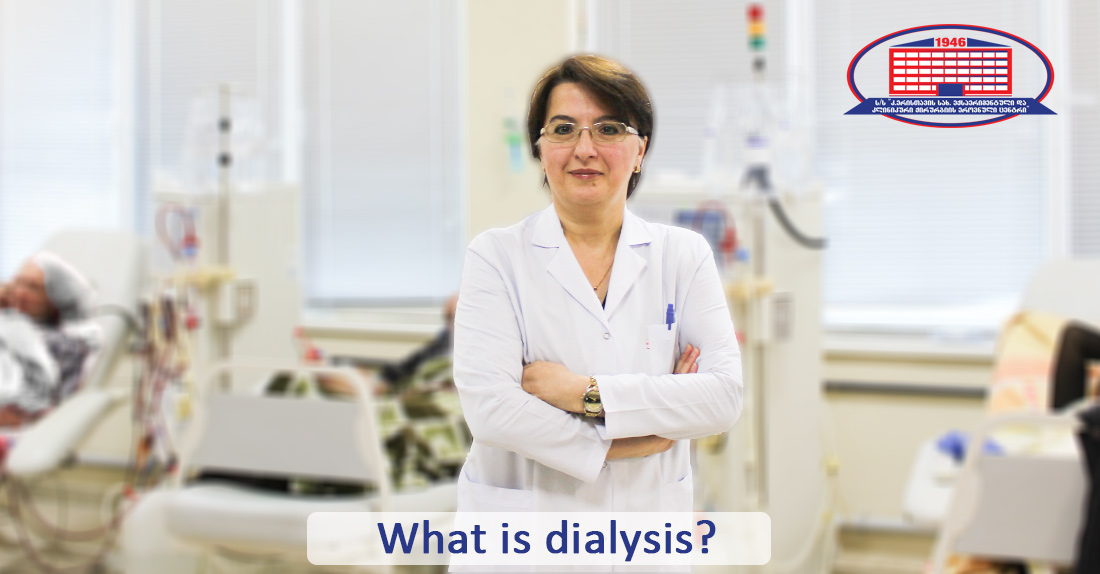
Dialysis is renal replacement therapy.
Dialysis is ordered when a kidney cannot function properly. Its' primary purpose is to artificially remove metabolic waste and excess water from the body.
Dialysis has been carried out successfully at the Nephrology, Hemodialysis and Transplantation Department of National Center of Surgery for more than 20 years.
Department serves patients under the state program on the basis of elective treatment. The procedure is conducted daily in three shifts and according to up-to-date data, around 160 beneficiaries participate in this program.
It’s worth mentioning that conditions for managing emergency clinical cases are also met in the Intensive Care and Emergency Department. Said services are available 24 hours!
Each member of the department tries her/his best to create a comfortable and safe environment for the patients. As you might know, half-sitting upright for 4 hours is not comfortable, but for patient's comfort and support, the leadership of the clinic has decided to equip the room with TV, high-quality internet – if beneficiary wishes, s/he can read a book, listen to a pleasant melody, etc.
Medical tourism is successfully conducted in the department and the clinic has received numerous international dialysis patients as guests. There have been no delays in the procedure of hemodialysis. Numerous dialysis patients under the program who receive elective treatment in other clinics, receive program dialysis in our clinic as an emergency caused by circumstances of subjective kind.
Nephrologist of National Center of Surgery, Nana Sadunashvili discusses dialysis.
– Dr. Nana, what should we know about hemodialysis and peritoneal dialysis?
– There are two types of dialysis: hemodialysis and peritoneal dialysis.
In hemodialysis, “artificial kidney” cleans blood from uremic toxins. In the “artificial kidney” device blood-cleansing procedure is based on the semi-permeable membrane.
In peritoneal dialysis, uremic toxins and excess fluids are transported from the blood through the peritoneum of the abdomen. Mentioned toxins move to pre-instilled dialysis fluids, and then are discharged.
In hemodialysis, as well as peritoneal dialysis, cleansing the blood from toxins and removal of excess water is conducted on the basis of diffusion, ultrafiltration, and convection.
In emergency cases, a double-lumen central venous catheter is used to initiate hemodialysis. The catheter is placed in the jugular, subclavian or femoral veins. We use short-term, as well as long-terms catheters, afterward, 3-6 weeks after the operation, arteriovenous fistulae/prosthesis puncture is indicated.
– In the clinic, dialysis is individually selected for every patient, particularly, what kind of criteria are you guided by?
– We individually select dialyzer, consistency of dialysis fluid, blood flow and ultrafiltration speed based on each patient’s weight, arterial pressure and weight gain between dialysis sessions.
After the patient is seated, the arterial pressure is measured. After the skin is debrided using antiseptic solution, arterial/venous fistulae puncture is feasible: arterial needle is connected to arterial magistral, whereas, venous – venous magistral and thus, an extracorporeal contour is connected to the body.
Arteriovenous fistulae puncture is moderately painful for the patient. Altering arterial pressure might occur during a procedure. That’s why constant monitoring and symptomatic treatment are at place.
After the end of the procedure, blood in extracorporeal contour returns to the patient and an arteriovenous needle is removed. Short-term (5-10 minutes) pressure is necessary to stop the bleeding at the site of puncture. Before patient stands up, blood pressure must be measured to avoid orthostatic collapse. Also, it’s necessary to asses the weight after the end of the procedure.
–When is dialysis not conducted?
– Absolute contraindication of hemodialysis are:
- Acute hemorrhagic stroke;
- Acute bleeding;
- Critical, terminal state of a patient.
In all of those cases, the procedure proceeds on a vital basis (when the patient dies without an artificial kidney).
National Center of Surgery is a multi-field clinic and this characteristic is especially important for the department of hemodialysis, because if patients under the program need, doctors of different field besides nephrologist, for example, hematologists, s/he will have the support of the powerful and large department of hematology. The presence of doctors of various fields and all examinations in one space maximizes the ability to manage the most complex clinical cases.
– Of course, the rhythm of life of dialysis patients is limited to some extent, but could you tell us if there are any categorical restrictions?
– Yes, the rhythm of life of dialysis patients is limited to some extent, albeit the majority of patients return to their job/educational establishment. In this case, patient and doctor in-charge work on the work/university and dialysis schedule so it doesn’t overlap. Dialysis patient can travel and receive dialysis in any dialysis units of Georgia within the state hemodialysis program. As for traveling abroad, it’s possible as well. Patient contacts the dialysis unit of the preferred city and come to agreement on time and financial aspects.
When patient on dialysis thoroughly follows every recommendation of doctor in-charge, s/he doesn’t have trouble traveling, working actively, studying with honors, etc.
Wish you health!







